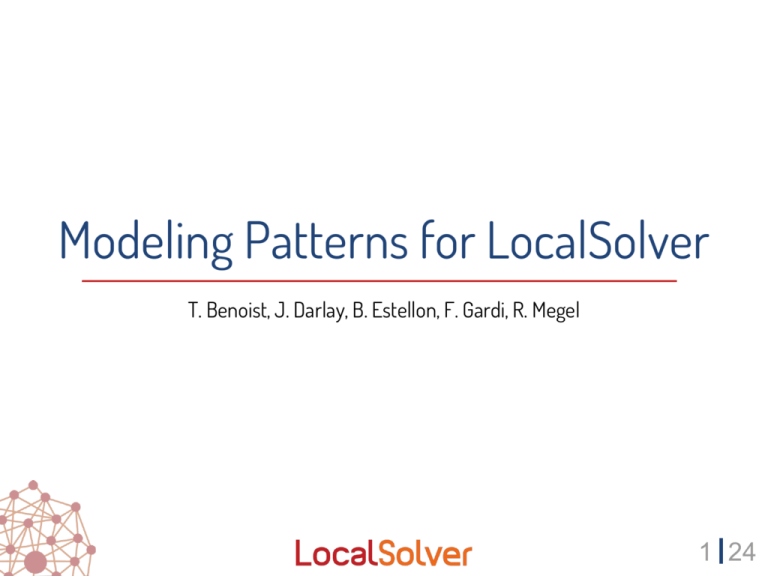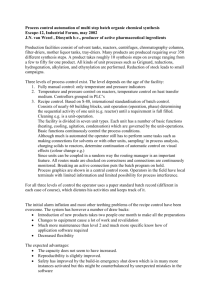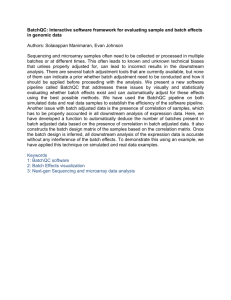the presentation in english
advertisement

Modeling Patterns for LocalSolver
T. Benoist, J. Darlay, B. Estellon, F. Gardi, R. Megel
1 24
Who we are
Large industrial group with businesses in
construction, telecom, media
www.bouygues.com
Operation Research subsidiary
of the Bouygues group
www.innovation24.fr
Flagship product
of Innovation 24
www.localsolver.com
2 24
LocalSolver in one slide
Select a set S of P cities among N
Minimizing the sum of distances
from each city to the closest city
in S
function model() {
x[1..N] <- bool();
constraint sum[i in 1..N] (x[i]) == P;
}
minDistance[i in 1..N] <- min[j in 1..N] (x[j] ? distance[i][j] : +inf);
minimize sum[i in 1..N] (minDistance[i]);
Results on the OR Library
• 28 optimal solutions on the 40 instances of the OR Lib
• an average gap of 0.6%
• with 1 minute per instance
3 24
LocalSolver in one slide
Select a set S of P cities among N
Minimizing the sum of distances
from each city to the closest city
in S
function model() {
x[1..N] <- bool();
constraint sum[i in 1..N] (x[i]) == P;
}
minDistance[i in 1..N] <- min[j in 1..N] (x[j] ? distance[i][j] : +inf);
minimize sum[i in 1..N] (minDistance[i]);
Results on the OR Library
• 28 optimal solutions on the 40 instances of the OR Lib
• an average gap of 0.6%
• with 1 minute per instance
4 24
LocalSolver in one slide
Select a set S of P cities among N
An hybrid math
Minimizing the sum of distances
from each city to the closest
city
programming
solver
in S
function model() {
x[1..N] <- bool();
constraint sum[i in 1..N] (x[i]) == P;
For large-scale mixed-variable
non-convex
optimization
minDistance[i in
1..N] <- min[j in 1..N]
(x[j] ? distance[i][j] : problems
+inf);
}
minimize sum[i in 1..N] (minDistance[i]);
Results
on the OR high-quality
Library
Providing
solutions
• 28 optimalin
solutions
the 40 instances
short on
running
time of the OR Lib
• an average gap of 0.6%
without
any tuning
• with 1 minute
per instance
5 24
Outline
LocalSolver
Modeling Patterns for Local Search ?
Six Modeling Patterns
6 24
Modeling Patterns for LocalSolver
Why ?
7 24
Modeling patterns ?
A classic topic in MIP or CP
Very little literature on modeling for Local Search…
…because of the absence of model-and-run solver
models and algorithms were designed together and not
always clearly separated
8 24
Modeling Pattern #1
Choose the right set of decision variables
9 24
Choose the right set of decision variables
Select a set S of P cities among N
Minimizing the sum of distances
from each city to the closest city
in S
function model() {
x[1..N] <- bool();
constraint sum[i in 1..N] (x[i]) == P;
}
minDistance[i in 1..N] <- min[j in 1..N] (x[j] ? distance[i][j] : +inf);
minimize sum[i in 1..N] (minDistance[i]);
Results on the OR Library
• 28 optimal solutions on the 40 instances of the OR Lib
• an average gap of 0.6%
• with 1 minute per instance
10 24
Modeling Pattern #2
Precompute what can be precomputed
11 24
Precompute what can be precomputed
Document processing : dans un tableau une case de texte a plusieurs configurations
hauteur x largeur possibles.
LocalSolver : mathematical
programming by local search
29 x 82
LocalSolver :
mathematical
programming by
local search
34x 61
LocalSolver :
mathematical
programming
by local search
45x 43
Comment choisir la configurations de chaque case de façon à minimiser la hauteur du
tableau (sa largeur étant limitée) ?
12 24
Precompute what can be precomputed
Première modélisation : 1 variable de décision par configuration (largeur, hauteur)
possible pour chaque cellule
Formulation étendue :
• On remarque qu’à partir de la largeur d’une colonne on peut déterminer la hauteur
minimum de chacune de ses cellules.
• 1 variable de décision par largeur possible pour chaque colonne
• Conséquence : en changeant une variable de décision, LocalSolver va changer la
hauteur et la largeur de toutes les cellules dans la colonne
-> R. Megel (Roadef 2013).
Modélisations LocalSolver de type « génération de colonnes » .
13 24
Modeling Pattern #3
Do not limit yourself to linear operators
14 24
Do not limit yourself to linear operators
TRAVELING SALESMAN PROBLEM
MIP approach: Xij=1 if city j is after city i in the tour
• Matching constraints
𝑗 𝑋𝑖𝑗
= 1 and
𝑖 𝑋𝑖𝑗
=1
• Plus an exponential number of subtour elimination constraints
• Minimize
𝑖𝑗 𝑐𝑖𝑗 𝑋𝑖𝑗
Polynomial non-linear model: : Xik=1 if city i is in position k i in the
tour
• Matching constraints
•
𝑌𝑘 ←
𝑖 𝑖𝑋𝑖𝑘
• Minimize
𝑘 𝑋𝑖𝑘
= 1 and
𝑖 𝑋𝑖𝑘
=1
the index of the kth city of the tour
𝑘 𝑐[𝑌𝑘 ,𝑌𝑘+1 ]
“at” operator
TSP Lib: average gap
after 10mn = 2.6%
15 24
Modeling Pattern #4
Separate commands and effects
16 24
Separate commands and effects
Multi-skill workforce scheduling
8h
9h
10h
11h
12h
13h
14h
15h
16h
17h
18h
19h
20h
Agent 1
Agent 2
Agent 3
Agent 4
Candidate model
Skillatk= 1 agent a works on skill k at timestep t
Constraint SUMk (Skillatk) <= 1
Constraint ORk (Skillatk) == (t [Starta, Enda[ )
Problem: any change of Starta will be rejected unless skills
are updated for all impacted timesteps
17 24
Separate commands and effects
Multi-skill workforce scheduling
8h
9h
10h
11h
12h
13h
14h
15h
16h
17h
18h
19h
20h
Agent 1
Agent 2
Agent 3
Agent 4
Alternative model
SkillReadyatk= 1 agent a will works on skill k at timestep t if present
Constraint SUMk (SkillReadyatk) == 1
Skillatk AND(SkillReadyatk , t [Starta, Enda[)
Now we have no constraint between skills and worked hours
-> for any change of Starta skills are automatically updated
18 24
Separate commands and effects
Similar case: Unit Commitment Problems
• A generator is active or not, but when active the production is in [Pmin, Pmax]
• Better modeled without any constraint
ProdReadygt float(Pmin,Pmax)
Activegt bool()
Prodgt Activegt ProdReadygt
19 24
Modeling Pattern #5
Invert constraints and objectives ?
20 24
Invert constraints and objectives
Clément Pajean
Vendredi 28
Modèle LocalSolver d'ordonnancement d'une machine unique
sous contraintes de Bin Packing
14h
Bât B TD 35
21 24
Modeling Pattern #6
Use dominance properties
22 24
Use dominance properties
D
Batch 1
Batch scheduling for N jobs
having the same due date D.
Completion time of each job
will be that of the batch
selected for this job
Linear late or early cost (k k)
We can minimize a minimum
As if starting date was automatically
adjusted after each move
Basic Model
Batch 2
Batch 3
Batch 4
Batch 5
Date variable for each batch
+ assignment of jobs to batches
+ Precedence constraints
D
Batch 1
No idle time
Batch 2
Batch 3 Batch 4 Batch 5
Only one starting date variable
+ assignment of jobs to batches
Batch 1
Batch 2
Batch 3 Batch 4 Batch 5
Optimal start will
No start date variable
position due date at + assignment of jobs to batches
the end of a batch
+ penalty[k] if due date at the end of batch k
Minimize min[k in 1..5](penalty[k])
23 24
Summary
1.
Choose the right set of decision variables
2. Precompute what can be precomputed
3. Do not limit yourself to linear operators
4. Separate commands and effects
5. Invert constraints and objectives ?
6. Use dominance properties
24 24
Modeling Pattern #7
Your turn!
25 24
Why solving a TSP with LocalSolver ?
Time 𝐴, 𝐵, 𝑇 =
2 𝛼𝑥 2 +𝛼𝑦 2
−2 𝛼𝑥 𝛽𝑥 +𝛼𝑦 𝛽𝑦 + 4 𝛼𝑥 𝛽𝑥 +𝛼𝑦 𝛽𝑦
2
−4 𝛼𝑥 2 +𝛼𝑦 2 𝛽𝑥 2 +𝛽𝑦 2 −𝑉²
+𝑇
With 𝛼𝑥 , 𝛽𝑥 , 𝛼𝑦 , 𝛽𝑦 function of A,B and T
Kinetic TSP
26 24
Choose the right set of decision variables
Industrial « Bin-packing »
Assignment of steel orders to « slabs » whose capacity can take only 5
different values
Slabs
Model
Order i is assigned
Xij= 1
to slab j
Yjk= 1
Slab j takes
capacity k
Minimize total size of slabs
27 24
Choose the right set of decision variables
Industrial « Bin-packing »
Assignment of steel orders to « slabs » whose capacity can take only 5
different values
Change
Exchange
Ejection chain
Slabs
In a good model:
Slab j takes
Order i is assigned
Y
=
1
Model
computed from others itjk is defined
ij= 1be
capacity
k operator
• when a value Xcan
with
to slab j
<- (it is an intermediate variable )
• moving from a feasible solution to another feasible solution only
requires modifying a small number of decision variables.
28 24
Choose the right set of decision variables
Industrial « Bin-packing »
Assignment of steel orders to « slabs » whose capacity can take only 5
different values
Change
Exchange
Ejection chain
Slabs
Model
Xij= 1
Order i is assigned
to slab j
Capak MinCapa[contentk]
“at” operator
29 24
Modeling patterns for Mixed-Integer Programming
•
•
•
MIP requires linearizing non linear structures of the problem
The polyhedron should be kept as close as possible to the
convex hull -> valid inequalities, cuts, and so on
Symmetries should be avoided (or not…)
30 24
Modeling patterns for constraint programming
Choice of variables (integer, set variables, continuous…)
Choice of (global) constraints
Redundant constraints
Double point of view (with channeling constraints)
And so on
31 24
Modeling patterns for Local Search ?
Very little literature on this topic…
…because of the absence of model-and-run solver
models and algorithms were designed together and not
always clearly separated
32 24
www.localsolver.com
1/18







